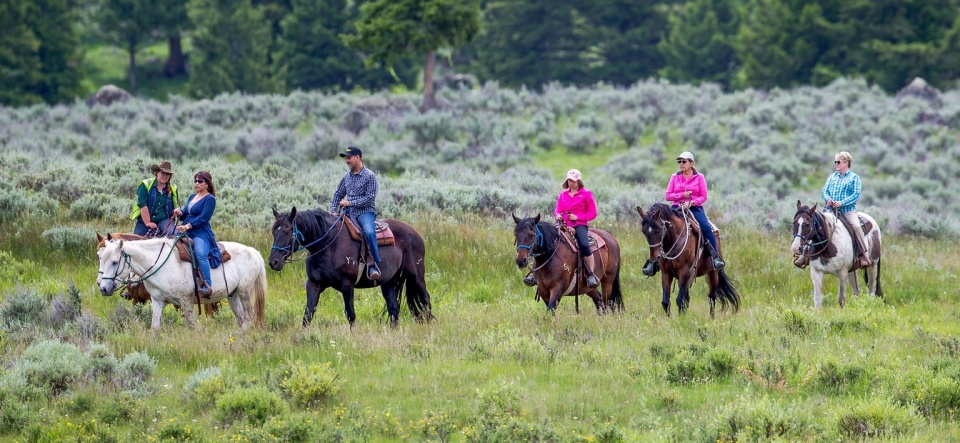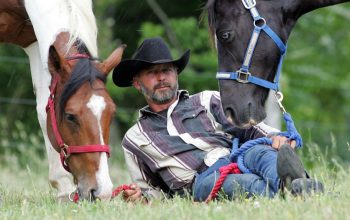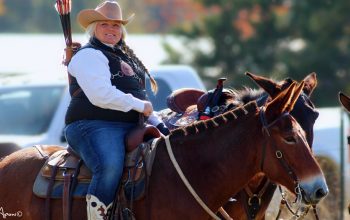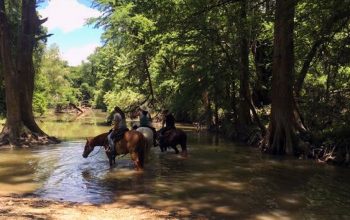Story and photography by Ozana Sturgeon
“Always respect Mother Nature. Especially when she weighs 400 pounds and is guarding her baby”- James Rolling
Words can’t describe what it’s like to ride into the backcountry and embrace the ultimate calm and pristine beauty of the wilderness as you let all of the hustle, bustle, worries and problems of your world fall out of sight and out of mind. Spring, summer and fall are excellent times to trail ride the wide open spaces and deep forests of our national parks, and enjoy the wildlife from the back of a horse.

Recently we had the chance to ride in the Greater Yellowstone Ecosystem Area. In a park that sees more than four million visitors a year, the best way to see some of Yellowstone’s 2.2 million acres without the crowds is from the back of the horse. Yellowstone’s abundant and diverse wildlife are as famous as its geysers. There are nearly 300 species of birds, 16 species of fish, five species of amphibians and 67 species of mammals—including seven native ungulate species and two bear species. Sharing the trails with wildlife and getting to watch thousands of wild bison nearby and elk herds, pronghorns and bighorn sheep it’s really an amazing site. While we rejoice at finding clues and signs of our favorite wildlife while out and about, the truth is we are seen by wildlife far more than we ever see wildlife.
And when trail riding out into the backcountry, with every new trail we enter, we enter into Bear Country! How often do people really see bears when out on the trails? Is it really that big of a deal? That of course depends of in what part of the country you ride in. But in the three days of riding around Yellowstone and the Grand Tetons National Park we saw five bears. That serves as a powerful reminder of how wild Yellowstone truly is, and why it’s so important to go prepared……
“Do you see the grizzly bear? Right there… on the trail… that dark hump in the grass!”

Horse trails do make good bear trails as well. And without a bit of knowledge and a bit of proper prior preparation to prevent poor performance, things could become a problem and invite conflict, then either bears get shot or trails get closed, or in some cases people or horses get hurt. When people say bears can be dangerous, it’s no joke!
Your safety cannot be guaranteed, but you can play an active role in protecting yourself and the bears. Review the best practices before you trail ride in bear country, and learn what to do if you encounter a bear. Learn about bear spray, a highly effective, non-lethal bear deterrent. Make sure you know what areas are closed for bear management.


While most bears do their best to avoid the people riding around their backyard, every time you embark on an adventure into bear country you’re opening the door for a bear encounter. Bears are naturally afraid of humans, but as the lines between bears and humans become less defined, bears become more audacious in our presence. This is especially true in areas where they’re accustomed to seeing us, like on the trails. As the saying goes: “Prior proper preparation prevents poor performance”.
You can protect yourself, and the bears, by following these safety guidelines.
- Avoid riding alone if possible. A group makes more noise than a single rider, increasing your chances of giving any bears in the area a heads up. Hiring a local guide is always a good idea. And be sure to have some veteran or local mountain horses with you on the ride. Horses that are acclimated to the area get pretty trail-savvy, and it takes a lot to spook them. A horse spooking can sometimes pose more danger than the bear itself.
- Make a lot of noise by talking, clapping and singing to avoid startling a bear. Chances are a bear isn’t going to linger on the trail if he expects a circus to crest the hill at any moment. Despite what you may have heard, bear bells may not be enough to alert a bear of your presence so don’t rely on them.
- Stick to the trail. It may take some of the adventure out of your ride, but by staying on the trail you’ll minimize potential bear encounters.
- Avoid bear food. If you smell something dead or see a carcass or see birds circling overhead, avoid the area. You don’t want to encroach on a bear food source. Never approach a carcass. Riders should detour around carcasses and any bears they encounter, or turn around and return the way they came.
- Be aware of your surroundings. Headwinds, running water, a curve in the trail or dense vegetation all increase your chances of surprising a bear. Use caution and make plenty of noise before approaching areas where a bear may not hear, smell or see you coming.
- Trail ride during the daylight hours. Bears are most active during early morning and late afternoon hours in the spring and summer. We all love trail riding at sunrise or sunset, but in bear country, this can increase your odds of coming across a bear.
- Avoid areas known to have a high bear population. Research the location you plan to ride and find out if it is known for bear activity.
- Watch for signs of bear – tracks, scat and markings on trees are all good indicators. Find out what kind of bears might be in the area you plan to trail ride and what kind of specific signs to look for.
- Avoid wearing scented lotions or perfumes on the trail. Don’t test a bear’s nose.
- You’ve probably heard it before, but if you encounter a bear while trail riding, fight the urge to run away. Your attempt at flight could trigger the bear’s predatory response. Instead, stand calmly and assess the situation.
- If the bear doesn’t know you’re there, quietly and calmly leave the area – no harm, no foul. Please, don’t take the opportunity to get closer to snap a selfie with said bear.
- If the bear sees you, don’t dismount, with all bears it’s important that you appear larger. Talk to the bear and slowly wave your arms up and down to identify yourself as a human without making eye contact. On a good day, the bear will just walk away or go back to what he was doing. If that’s the case, slowly back away from the bear in the opposite direction from which he went or just away from the situation. Continue to talk and move your arms as you retreat.
- If the bear attacks, how to react depends on the species, so you will need to be able to tell them apart. Grizzlies have a dished face, large claws, and a pronounced shoulder hump. Black bears have a flat/roman nose profile, small claws, and no shoulder hump.
- Grizzlies generally attack out of a defensive nature. Black bears are known to be less aggressive than grizzlies but when they do attack, it’s generally with a predatory motive. If a black bear charges you, it would be wise to fight back as it is probably not acting defensively and won’t stop.
- If a bear is acting aggressively toward you, charging or attacking, it would be a fine time to use your bear spray and hope for the best. A report by the U.S. Fish and Wildlife Service found that individuals who used a firearm to protect themselves from a bear attack were 50% more likely to accrue injury compared to those who used bear spray. So, please, always pack your spray and know how to use it.

Bear spray is proven to be highly successful at stopping aggressive behavior in bears.
Tips for Use
- Keep bear spray readily accessible in a quick draw holster, not stored in your horse’s pack.
- You don’t have to be a good shot with bear spray. Just put up a cloud of spray between you and the charging bear.
- Practice! Use an inert can of bear spray to practice removing it from your holster, removing the safety tab with your thumb, and firing. Practice firing inert bear spray with the wind at your back, into a head wind, and with a cross-wind so that you understand how bear spray is affected by the wind.
- Make sure your bear spray is EPA-approved: don’t depend on personal defense products to stop a charging bear.
- Bear spray can explode if it reaches 120 degrees Fahrenheit. Don’t store it in the passenger compartment of vehicles or near any heat sources.
- Make sure your bear spray hasn’t expired.
- If a Bear Charges You
- Remove the safety clip
- Aim slightly down and adjust for crosswind
- Begin spraying when the charging bear is 30-60 feet (10-20 yards) away
- Spray at the charging bear so that the bear must pass through a cloud of spray
- Keep spraying until the bear changes direction
- If the bear continues to charge, spray into its face

Leave the area promptly
Personal defense, jogger defense, law enforcement or military defense sprays may not contain the correct ingredients, or have the proper delivery system, to stop a charging bear. Bear spray uses a fine cloud of Capsicum derivatives to temporarily reduce a bear’s ability to breathe, see, and smell, giving you time to leave the area. If you’re involved in a conflict with a bear, regardless of how minor, you should report it to a park ranger as soon as possible.
Also a lot of different organizations can also provide you with advice before you head out into the wilderness; Back Country Horsemen of America, the American Endurance Ride Conference or the North American Trail Ride Conference.
Stay alert but not paranoid. Riding along wildlife it’s what the pleasure of trail riding it’s all about.
I hope you will enjoy some of the pictures of the wildlife that we encountered. And bears are not the only ones you need to be careful around. The animals in Yellowstone are wild and unpredictable, no matter how calm they appear to be. Always stay at least 100 yards away from bears and wolves, and at least 25 yards away from all other animals, including bison and elk.





